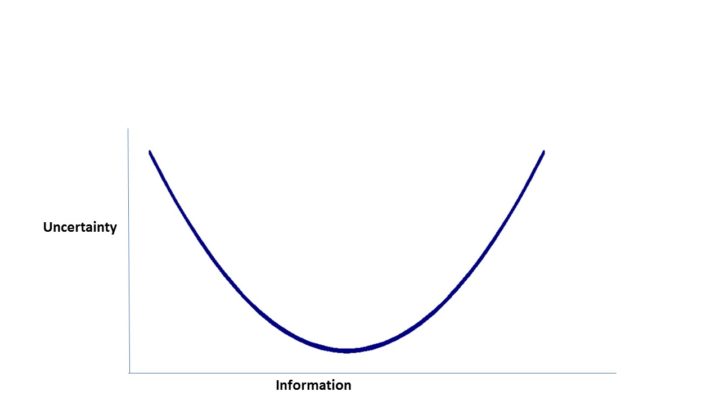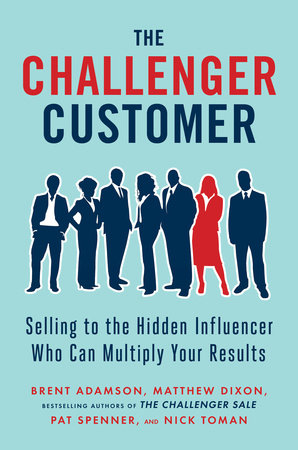One of the tenets of lean is constant and continuous improvement, and in that spirit I have modified my model slightly, thanks to a new Harvard Business Review article by Nick Toman and Brent Adamson, The New Sales Imperative.
As I’ve written before, your purpose—in fact, the only reason salespeople are relevant—is to help your customers make effective buying decisions. Complex decisions can’t be made without investing time and effort to gather, understand, analyze and apply a lot of information, but salespeople often make it much harder than it should be. To that end, the goal of Lean Communication for Sales is to improve your buyers’ RoTE, or Return on Time and Effort. In lean terms, you provide useful information that helps improve their outcomes, and express it concisely and clearly.
To a great extent, their article reinforces what I’ve been saying about the importance of making it easier for people to decide. As their research shows, making buying easier results in a 62% increase in the likelihood of winning a high-quality sale.
But as new research that Toman and Adamson adduce shows, there is another hidden form of waste that needs to be removed from the buying journey: uncertainty. Their research shows that customers are “deeply uncertain and stressed”, and second-guess their decisions more than 40% of the time! This uncertainty can be paralyzing, and paradoxically it’s the good intentions of the salesperson that exacerbates it. That’s because they try to be responsive and attack uncertainty with even more information. But unfortunately, beyond a certain point, more information and more choice actually increases uncertainty, as you can see in the figure above.
This is a useful reminder, but most of us already have at least an inkling of this. The real difficulty is figuring out where the bottom of that curve is so that you can get uncertainty as low as possible but then stop. That’s where their article is particularly helpful. They lay out a four-step approach for being less responsive and more prescriptive. Out of deference to them and to HBR, I’m not going to try to summarize their ideas here—I encourage you to read it here.
What I am going to do, however, is spend some serious time thinking about how to incorporate the idea of reducing uncertainty into Lean Communication for Sales. As a start, I’m changing the goal of improving RoTE to RoUTE!
The folks at CEB have done it again—written a book that challenges traditional thinking about B2B sales and introduced a new character in the long-running conversation about understanding and influencing the customer’s decision making process.
Trying to describe the ideas in The Challenger Customer: Selling to the Hidden Influencer Who Can Multiply Your Results reminds me of the guy who took a speed-reading course and then bragged that he had read War and Peace in an hour. When asked for a synopsis of the book, he said: “It’s about Russia.”
In that spirit, The Challenger Customer is about helping your customers buy. In sales, we lament how hard selling is nowadays; buyers have far more knowledge earlier in the sales cycle and use it to drive even complex solutions to commodity status. The problem with that is that often it’s not in the buyer’s own best interests to buy the lowest-cost solution, yet many buyers make the sub-optimal decision because they can’t help it: buying is harder than ever before.
Buying is harder because more stakeholders are involved: an average of 5.4 stakeholders in complex B2B deals, according to the book. That’s complicated by the fact that the most important attribute that senior decision makers consider when choosing a supplier is widespread support across the organization.
The traditional sales response to this challenge is to simply work harder. If you need to get more yesses to close the sale, you just have to call on more people and get their buy-in, right? The revelation—at least to me—is that, that strategy will actually make it less likely that you will get the sale. In other words, 1+1+1=0! That’s because each stakeholder will support the deal for their own reasons, and the overlap among interests becomes harder to achieve as the number of stakeholders rises. As a result, the decision gets driven down to the lowest common denominator: either status quo or the simplest, cheapest choice.
The challenge, then, is not to get a serial collection of yesses, but a collective yes, in which each stakeholder converges around a common vision. It’s like the parable of the six blind men and the elephant. Each one sees only a small part of the whole, so someone needs to make them see the whole elephant. That’s a daunting task for any salesperson, but fortunately there’s a solution: enter the Mobilizer.
The Mobilizer is the internal Challenger, the person who is willing to make waves to and drive the vision. They will only do it if they perceive that the pain of staying the same is greater than the pain of change. The book explains in great detail how to identify the three types of mobilizers, get them to agree on the need for change, and then coach and equip them to sell the need internally.
I give The Challenger Customer five stars for three reasons:
- It’s very much about outside-in thinking. Start from the customer’s perspective, understand their need to change, and don’t lead with your product.
- Just like their first book, The Challenger Sale, it’s backed up by tons of primary research, very credible examples, and detailed implementation suggestions.
- The third reason is why I didn’t like the book on first reading, and then I did: the approach and techniques are devilishly difficult. You have to learn how to identify mobilizers, tailor your approach to each of the three types, help them get the message across effectively to the other stakeholders, produce the right materials, and a host of other challenges. But by the second reading, I realized that the difficulty is actually the best reason for a company or even an individual sales rep to adopt the approach. If it were easy, anyone could do it, and then it would not be an advantage anymore.
That said, this is not really a book for salespeople. Only a select few (like the type who reads this blog, wink-wink) would be able to master the techniques. It takes a joint effort by sales and marketing to generate the insights and produce the materials to equip the Mobilizer to sell the insights internally, and it won’t happen overnight.
I suggest you read this book, study it, challenge it, and most importantly, use it to change the way you sell.
Dismantling the Sales Machine, by Brent Adamson, Matthew Dixon and Nicholas Toman in this month’s Harvard Business Review is a well-timed and well-aimed shot at what has become entrenched “wisdom” in selling today. If you’re in sales management, you should get your hands on the entire article. I would first like to summarize the main points of the article, and then give my own commentary.
The title is a bit misleading. The “machine” they urge to be dismantled is not the sales organization; far from it: sales today is even more important than ever. The machine that should be dismantled is the current sales process. The authors’ first point is that the current fixation on process discipline is broken, and is causing all kinds of woes such as lower margins, longer sales cycles, and less reliable forecasts. The reason is that buyers are engaging suppliers much later in their own process, so that they already have defined their needs and identified available solutions. What remains is a competitive process in which suppliers have little room to do anything but respond as quickly as possible with the lowest possible price. So in order to compete, managers stress strict compliance with sales process and discipline, to give the sales force a chance to respond faster and more efficiently than the competition.
Second, the only way to rise above this squeeze is to change the game by challenging the customers’ thinking and offering unexpected solutions, and this can only be done early in the sales cycle. The emphasis has to go from efficiency of response to the effectiveness of demand creation. While efficiency is best promoted by flowing the shortest distance between two points, there is no one best way to proceed through the sales cycle, so there is a premium on individual judgment and creativity in finding ways to shape the customer’s thinking about the situation.
The hard part, of course, is moving from the first point to the second, and this where sales management has to radically change its approach, in several ways. At the risk of oversimplification, they are:
- First, managers need to learn to let go and become facilitators and coaches instead of enforcers, because salespeople who are smart and adaptable sales reps who have the confidence to challenge their customers will not submit to tight command and control.
- Because insight-based sales require a longer-term focus, managers need to focus on long-term measurable results rather than a short-term focus on activity, and add value by helping reps think creatively about ways to change their customers’ thinking.
- Measurements have to focus on outputs rather than inputs.
- Emotional intelligence, or EQ, is no longer enough. Sales forces have to hire for IQ, critical thinking skills and judgment. Their own research shows that only 17% of current sales reps have the competencies needed to succeed.
- The climate and incentives also have to change. These types of sales reps are not as “coin-operated” as transactional reps; they will thrive in a climate that provides the intrinsic motivations of autonomy and more meaningful purpose.
Commentary
First of all, I agree with and applaud the general theme of the message. I applaud the emphasis on judgment, critical thinking and creativity on the part of reps. In my more than two decades of sales training, invariably the members of the sales force who stand out are those who go beyond the confines of their job description and see themselves as business problem solvers for their customers.[1] Unfortunately, they haven’t always had the support of their management in their efforts, so the fact that an influential publication such as the HBR gave them a forum for these ideas gives me encouragement that—just maybe—life will become easier for these top salespeople, and by extension better for their customers.
At the same time, I don’t agree that sale processes need to go away. In fact, the authors themselves say, ”Our data do not suggest that process and structure are always bad.” (As in their past writings, they set up a strawman that helps them emphasize their points.) Process should not go away, but it does need to be modified. Sales organizations tend to begin with a general, loosely structured set of activities that emerge from successful sales efforts. When these are used as guidelines they are immensely helpful in disseminating effective practices and bringing up the general level of performance. But good processes go bad because they tend to be evolve into tools for management convenience than for sales effectiveness. They gradually shift their focus toward activities and precise inputs because they are easier to measure and track than more vague outputs and customer agreements. Eventually they become ends in themselves rather than a means to an end, particularly when they are housed in those shrines called CRM systems.
But I digress…the article actually advocates its own “new” process, which differs from the old bad process in two ways. First, the sales funnel should be “customer-verified”, meaning that progress in the sales cycle is tracked by meaningful steps taken by the customer, such as running a pilot application or agreeing that status quo is untenable. Second, process activities need to be front-loaded, so that more work is done early to create the right kind of demand, not simply to respond to it when it’s too late to do anything about it.
Finally, I enjoy it when a new publication comes out from this trio of writers, because they actually do a great job of eating their own dog food. Their entire approach to selling is to provide disruptive insights, and I predict this article will toss a few bombs into more than a few boardrooms. Regardless of whether you agree entirely with what they write, they always make you think, and that’s the whole point, isn’t it?
[1] As a student of military history in my other life, I also find it ironic that the US Army learned about the value of putting judgment into the hands of people out in the field long before most sales forces have.
There is an article in the most recent issue of Harvard Business Review titled “The End of Solution Sales” by Brent Adamson, Matthew Dixon and Nicholas Toman. Their premise is that customers today are so well informed that they already know how to solve their own problems, so they don’t need sales reps to sell them solutions. Instead, the top performers sell “insights” to customers who have emerging needs or whose organizations are in a state of flux. They then go further, coaching their customers on how to buy.
Dave Brock took exception to their premise in his latest blog post. He offered an eloquent defense of the concept of solution selling, saying that the article is “wordsmithing and positioning”, and that insight selling is just a form of solution selling. As he said, “…if it looks like Solution Selling, smells like Solution Selling, sounds like Solution Selling, then it must be Solution Selling.” So, he lumps the two concepts together and then also throws Consultative Selling into the same pile for good measure.
My own perspective on the debate is that selling insights is different than solution selling, but that solution selling is still far from dead.
Definitions do matter…
I believe it’s useful to distinguish between the approaches,





